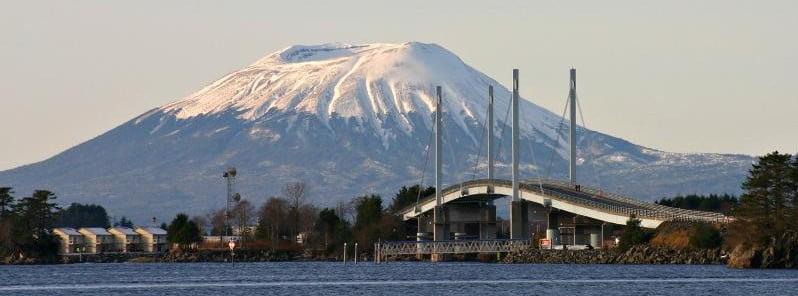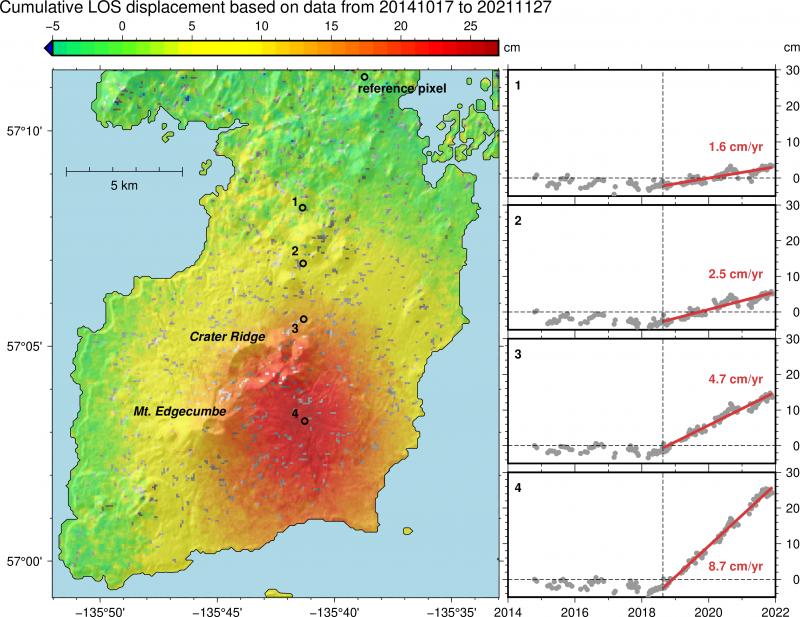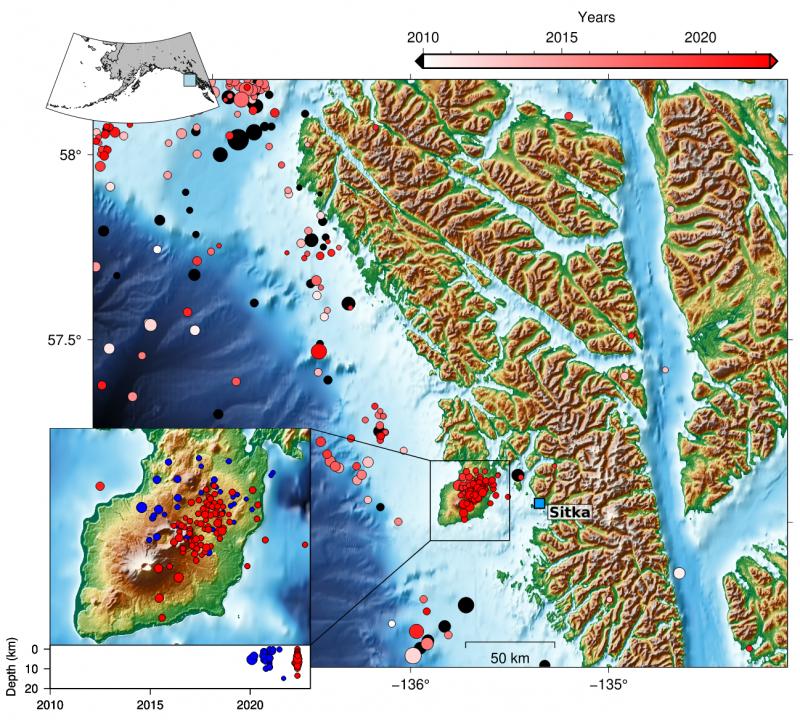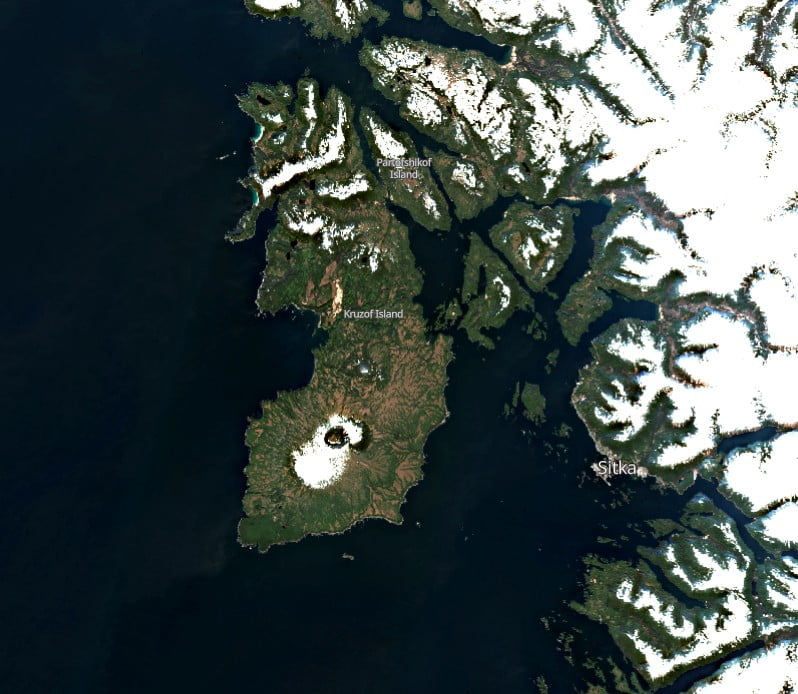Reactivation of dormant Edgecumbe volcano, Alaska

Researchers reporting in AGU’s Geophysical Research Letters show that the seismic swarm detected near Mt. Edgecumbe volcano in Southeast Alaska, U.S. in April 2022 was caused by magmatic activity taking place under this transform fault volcano previously considered dormant.
- As Edgecumbe is located near the major Queen-Charlotte Fairweather fault that separates the Pacific and North American plates, similar earthquakes were previously assumed to be tectonic
- While the eruption is not imminent, the activity at Edgecumbe presents a rare opportunity for observation of the reactivation of the dormant volcanic system
- The last eruption at this volcano took place in 2080 BCE ± 90 years
“Since magmatic activity at volcanoes is often accompanied by ground deformation, we analyzed available satellite radar data going back to the fall of 2014,” the authors noted.1
The analysis revealed ongoing crustal motion toward the satellite of up to 7.1 cm (2.8 inches) per year starting in August 2018.
Modeling of the deformation suggests that magma sourced from a gently dipping tabular body at a depth of 20 km (12.4 miles) is pooling at about 10 km (6.2 miles) depth.
“We believe that we are observing magma rising through malleable crust into an existing magmatic system and that the observed earthquakes are created as the overlying rock adjusts to the increased magmatic pressure. The observed activity is rare, especially in similar tectonic settings, and presents an opportunity to better understand the reactivation of dormant volcanoes.”

A retrospective analysis of earthquake data in the area of Mount Edgecumbe showed that a small number of earthquakes started occurring under the volcano in 2020.2
The recent earthquake activity that started on April 11 was unusual in having a greater number of events, however.
The earthquakes detected under the volcano since 2020 are all M3.0 or smaller.
Note that only the largest of the earthquakes can be located by regional seismic networks; hundreds of very small additional events have been detected, but not located.

In May 2022, the Mount Edgecumbe volcanic field (MEVF) was classed as “historically active” by the standards of the Alaska Volcano Observatory (AVO).3
AVO defines an “active” volcano as a volcanic center that has had a recent eruption or a period of intense deformation, seismic activity, and/or fumarolic activity that likely reflects the accumulation of magma in the crust below the volcano. Note that this definition does not require an actual eruption and instead uses eruptions as well as measurements of magma beneath a volcano.
AVO uses the term “historical” to mean within the past 300 years and the beginning of written records in Alaska.

Geological summary
The Pleistocene-to-Holocene Edgecumbe volcanic field covers about 260 km2 (100 miles2) of Kruzov Island west of Sitka in the SE panhandle of Alaska.
The basaltic-to-dacitic field is dominated by the large composite cones of Mount Edgecumbe, Crater Ridge, and Shell Mountain, and has an unusual tectonic setting only 16 km (10 miles) E of the Queen Charlotte-Fairweather transform fault separating the North American and Pacific plates.
Mount Edgecumbe is a stratovolcano with a well-defined crater and is the largest volcano in the field.
Crater Ridge is truncated by a 1.6 km (1 mile) wide, 240 m (787 feet) deep caldera. These and other vents are oriented along a SW-NE line.
Volcanic activity originated about 600 000 years ago along fissures cutting Kruzof Island.
A series of major silicic explosive eruptions took place about 9 000 – 13 000 radiocarbon years ago.
The latest dated eruptions were phreatomagmatic explosions during the mid-Holocene, and all postglacial activity has been pyroclastic. Reports of historical eruptions of Mount Edgecumbe are unsubstantiated.4
References:
1 Return From Dormancy: Rapid Inflation and Seismic Unrest Driven by Transcrustal Magma Transfer at Mt. Edgecumbe (L’úx Shaa) Volcano, Alaska – AGU Geophysical Research Letters – October 2022 – DOI: 10.1029/2022GL099464
2 EDGECUMBE VOLCANO – ALASKA VOLCANO OBSERVATORY INFORMATION STATEMENT U.S. Geological Survey – April 22, 2022
3 Mount Edgecumbe volcanic field changes from “dormant” to “active” — what does that mean? – Alaska Volcano Observatory – May 9, 2022
4 Mount Edgecumbe – Geological summary – GVP
Featured image: Mount Edgecumbe, viewed from Sitka, Alaska. Photo courtesy of Duncan Marriott

Commenting rules and guidelines
We value the thoughts and opinions of our readers and welcome healthy discussions on our website. In order to maintain a respectful and positive community, we ask that all commenters follow these rules.